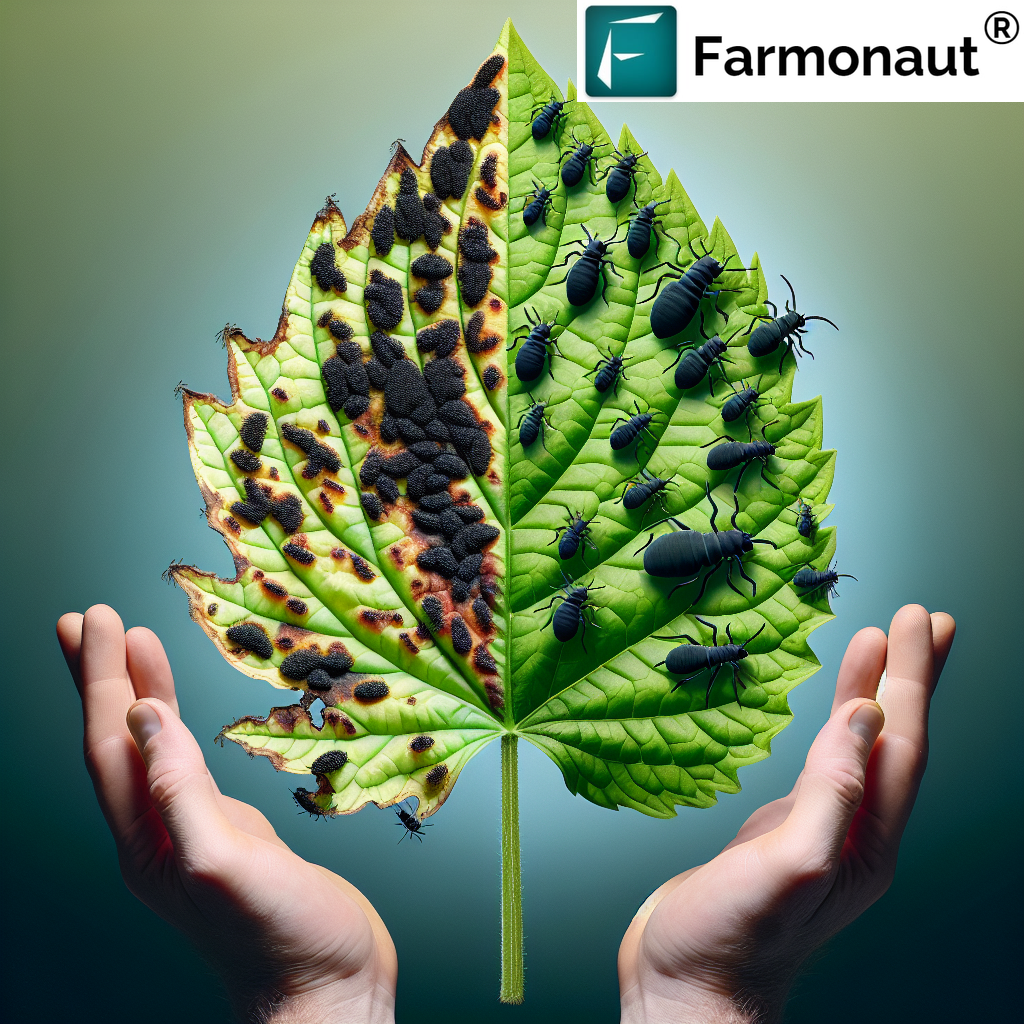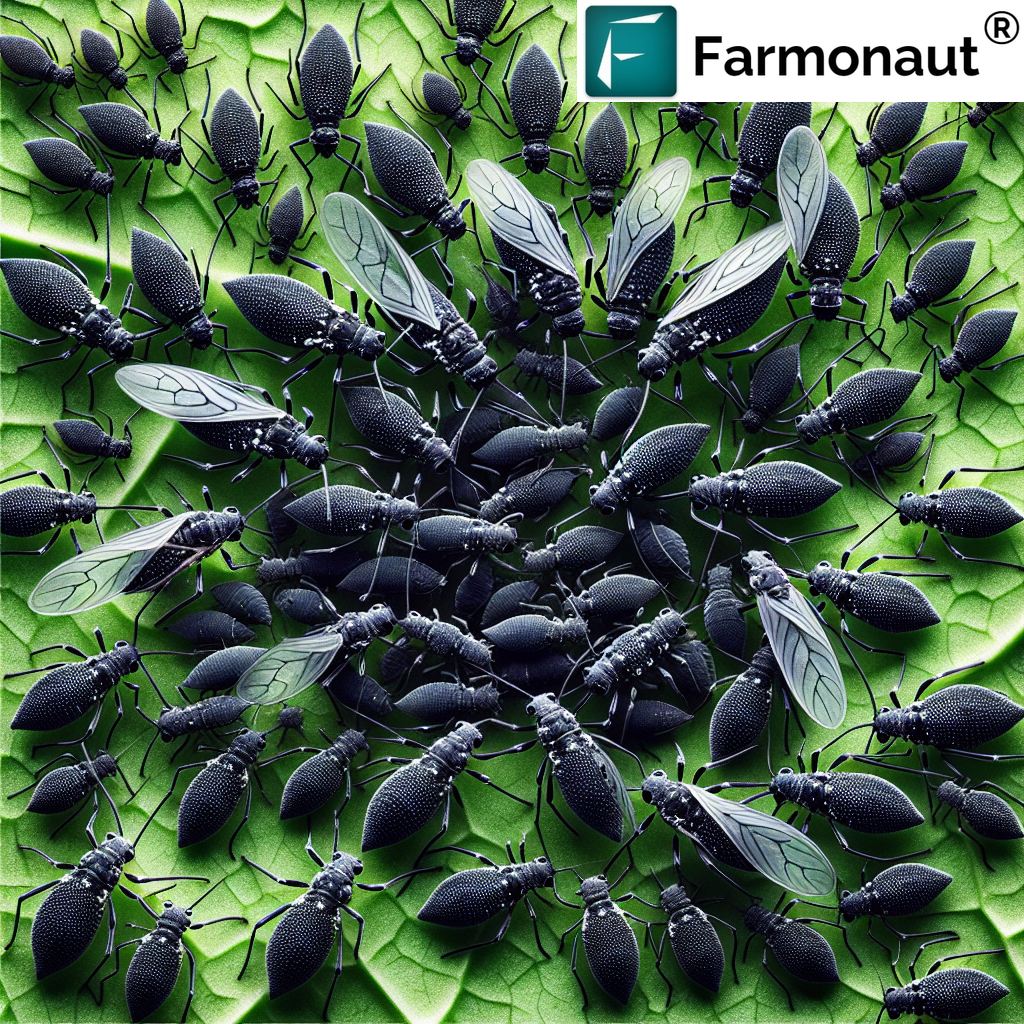Black Aphids: A Comprehensive Guide for Farmers

As farmers and agricultural experts, we understand the importance of identifying and managing pests that can harm our crops. One such pest that often causes concern is the black aphid. In this comprehensive guide, we’ll delve deep into the world of black aphids, exploring their identification, damage, and control methods. We’ll also discuss how modern agricultural technologies, like those offered by Farmonaut, can help in managing these pesky insects.
Understanding Black Aphids
Black aphids are small, sap-sucking insects that can cause significant damage to various crops. These pests are often referred to by different names, including black bean aphid and black fly aphid. Let’s explore some key aspects of these insects to help you better understand and manage them.
What Does a Black Aphid Look Like?
When farmers ask, “What does a black aphid look like?” we can provide a detailed description:
- Color: As the name suggests, they are primarily black, but some species may have a greenish or brownish tint.
- Size: Black aphid size is typically small, ranging from 1.5 to 3 mm in length.
- Body Shape: Pear-shaped with a soft body.
- Antennae: Long antennae protruding from the head.
- Cornicles: Two tube-like structures on the rear of the abdomen.
It’s worth noting that you might encounter black aphid with wings. These winged forms, known as alates, develop when the colony becomes overcrowded or when environmental conditions change, allowing the aphids to migrate to new host plants.

Black Aphid Scientific Name
The black aphid scientific name varies depending on the specific species. Some common black aphid species include:
- Aphis fabae – The black bean aphid
- Cinara cronartii – The black pine aphid
- Pterochlorus persicae – The black peach aphid
Understanding the specific species can help in developing targeted control strategies.
Black Aphid Damage: Recognizing the Signs
Black aphid damage can be severe if left unchecked. These pests feed on plant sap, which can lead to various issues:
- Stunted Growth: The loss of nutrients can slow plant growth and development.
- Leaf Distortion: Leaves may curl, yellow, or become misshapen.
- Honeydew Production: Aphids excrete a sticky substance called honeydew, which can lead to sooty mold growth.
- Virus Transmission: Some black aphid species can transmit plant viruses.
Early detection of black aphid infestation is crucial for effective management. Regular monitoring of crops, especially during warmer months, can help identify problems before they become severe.
The Life Cycle of Black Aphids
Understanding the life cycle of black aphids is essential for developing effective control strategies. Let’s break it down:
Egg Stage
In colder climates, black aphids often overwinter as eggs on host plants. These eggs are typically black and oval-shaped.
Nymph Stage
As spring arrives, the eggs hatch into nymphs. Black aphid larvae, or nymphs, go through several molts before reaching adulthood. During this stage, they’re wingless and resemble smaller versions of adult aphids.
Adult Stage
Adult black aphids can be either wingless or winged. The wingless forms are more common and remain on the host plant to feed and reproduce. Winged forms develop when conditions become unfavorable, allowing the colony to spread to new plants.
Reproduction
Black aphids have a remarkable ability to reproduce quickly. In favorable conditions, females can give birth to live young without mating, a process called parthenogenesis. This rapid reproduction rate is one reason why black aphid infestation can quickly become severe.
Black and Yellow Aphid: A Related Pest
While our focus is on black aphids, it’s worth mentioning the black and yellow aphid, which is sometimes confused with its all-black counterpart. These aphids, often of the species Sipha flava, can be found on various grasses and cereals. Their distinctive coloration makes them easy to identify, but their damage and control methods are similar to those of black aphids.
Black Aphid-Like Bugs: Differentiating Similar Pests
Farmers sometimes encounter black aphid-like bugs that may be mistaken for true black aphids. Some examples include:
- Black Whiteflies: Despite their name, some species appear black and can be confused with aphids.
- Black Scale Insects: These pests are often mistaken for aphids due to their small size and dark coloration.
- Black Thrips: These tiny insects can sometimes be confused with aphids, especially to the untrained eye.
Accurate identification is crucial for implementing the right control measures. When in doubt, consult with a local agricultural extension office or use Farmonaut’s AI-powered pest identification tools for accurate diagnosis.
Natural Enemies: Black Aphid Predators
Nature provides several black aphid predators that can help control populations naturally. Encouraging these beneficial insects can be an effective part of an integrated pest management strategy:
- Ladybugs (Ladybirds): Both adults and larvae feed voraciously on aphids.
- Lacewings: The larvae, known as “aphid lions,” are particularly effective predators.
- Hoverflies: Their larvae consume large numbers of aphids.
- Parasitic Wasps: These tiny wasps lay their eggs inside aphids, eventually killing them.
- Birds: Many bird species feed on aphids, helping to control populations.
Creating a diverse habitat with native plants can help attract and sustain these beneficial insects, providing natural pest control for your crops.
Controlling Black Aphid Infestations
When dealing with a black aphid infestation, a multi-faceted approach is often the most effective. Here are some strategies we recommend:
1. Cultural Control
- Crop Rotation: Alternating crops can disrupt aphid life cycles.
- Pruning: Remove heavily infested plant parts to reduce population density.
- Weed Control: Many weeds can serve as alternative hosts for aphids.
- Water Management: Proper irrigation can help plants withstand aphid attacks better.
2. Biological Control
- Encourage Natural Predators: Plant flowers and herbs that attract beneficial insects.
- Release Beneficial Insects: Commercially available ladybugs or lacewings can be introduced to the field.
- Use of Entomopathogenic Fungi: Certain fungi can infect and kill aphids naturally.
3. Chemical Control
While we always recommend starting with non-chemical methods, sometimes pesticides may be necessary for severe infestations:
- Insecticidal Soaps: These are effective against aphids while being relatively safe for beneficial insects.
- Neem Oil: This natural pesticide can disrupt aphid feeding and reproduction.
- Synthetic Insecticides: Use as a last resort and always follow label instructions carefully.
4. Integrated Pest Management (IPM)
Combining multiple control methods in an IPM approach is often the most effective and sustainable way to manage black aphids. This strategy involves:
- Regular Monitoring: Inspect crops frequently to catch infestations early.
- Threshold-Based Decision Making: Only apply control measures when pest populations reach damaging levels.
- Rotating Control Methods: This helps prevent the development of pesticide resistance.
Leveraging Technology for Aphid Management
At Farmonaut, we believe in harnessing the power of technology to improve farm management and pest control. Our satellite-based crop monitoring system can help detect stress in plants caused by aphid infestations before they become visible to the naked eye.
How Farmonaut’s Satellite System Compares to Drone and IoT-Based Monitoring
| Feature | Farmonaut Satellite System | Drone-Based Monitoring | IoT-Based Monitoring |
|---|---|---|---|
| Coverage Area | Large scale (100s to 1000s of hectares) | Medium scale (10s to 100s of hectares) | Small to medium scale (1s to 10s of hectares) |
| Frequency of Data Collection | Regular (every few days) | On-demand (requires manual flights) | Continuous |
| Initial Setup Cost | Low | High (drone purchase required) | Medium to High (sensors needed) |
| Operational Complexity | Low (automated) | High (requires trained operator) | Medium (maintenance of sensors required) |
| Weather Dependency | Low (can penetrate clouds) | High (affected by wind, rain) | Low |
| Data Analysis | Advanced AI-powered analytics | Requires separate analysis tools | Real-time but limited scope |
By using Farmonaut’s satellite-based monitoring system, farmers can:
- Detect early signs of stress caused by aphid infestations
- Monitor large areas efficiently without the need for physical inspections
- Receive alerts when potential problems are detected
- Make data-driven decisions about when and where to apply control measures
To learn more about how Farmonaut can help you manage pests like black aphids more effectively, visit our app page or explore our API documentation.
Conclusion
Managing black aphids requires a comprehensive approach that combines understanding their biology, recognizing the signs of infestation, and implementing effective control measures. By integrating traditional farming practices with modern technologies like those offered by Farmonaut, farmers can stay one step ahead of these persistent pests.
Remember, early detection and a balanced approach to pest management are key to maintaining healthy crops and maximizing yields. Whether you’re dealing with black bean aphids, black fly aphids, or any other aphid species, the principles outlined in this guide will help you protect your crops effectively.
FAQs About Black Aphids
- Q: How quickly can a black aphid infestation spread?
A: Black aphids can reproduce rapidly under favorable conditions. A small infestation can spread to cover an entire plant or crop area within a few weeks. - Q: Are black aphids harmful to humans?
A: Black aphids do not pose a direct threat to humans. However, they can significantly damage crops, which can indirectly affect food supply and quality. - Q: Can black aphids survive winter?
A: In colder climates, black aphids typically overwinter as eggs on host plants. In milder climates, they may remain active year-round. - Q: How can I differentiate between black aphids and other small black insects?
A: Black aphids can be identified by their pear-shaped bodies, long antennae, and the presence of cornicles (tube-like structures) on their abdomen. When in doubt, use a magnifying glass or consult with an agricultural expert. - Q: Are there any plants that repel black aphids?
A: Some plants known to repel aphids include marigolds, nasturtiums, and alliums (like garlic and chives). Planting these near susceptible crops may help deter aphids.
For more information on how Farmonaut can help you manage pests and optimize your crop production, download our app from the Google Play Store or the Apple App Store.
Subscribe to Farmonaut Services
By subscribing to Farmonaut’s services, you’ll gain access to cutting-edge satellite-based crop monitoring and pest management tools. Our technology can help you detect and manage black aphid infestations more effectively, leading to healthier crops and better yields.
For developers interested in integrating Farmonaut’s powerful APIs into their own applications, please visit our API documentation page.